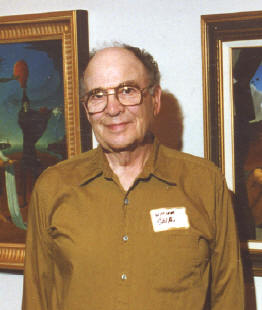 After the
start of the Second World War his father went to work in
a Bay Area shipyard. But their financial situation did not improve much. His father experienced a setback when he was injured at work.
He
suffered with this injury throughout the war years and was not able to work
full time. Bill's mother had to work to keep
the household afloat. That really put an end to Bill's thoughts of
attending art school after high school graduation.
After the
start of the Second World War his father went to work in
a Bay Area shipyard. But their financial situation did not improve much. His father experienced a setback when he was injured at work.
He
suffered with this injury throughout the war years and was not able to work
full time. Bill's mother had to work to keep
the household afloat. That really put an end to Bill's thoughts of
attending art school after high school graduation.
His
father had been an auto mechanic and Bill found that this work came easy for
him, so after
graduating from high school, he too became a mechanic. On his first
job he worked late into the night on the
swing shift which left him with free time during the day. Bill still
wanted to be an artist and put his free time to good use. He bought a set
of artist's paints and some brushes and began the long process of teaching
himself the art of putting paint to canvas. It went slow and he was not pleased
with his
progress, but he could not make the time for art school now that he was
married to Lois and was raising his own family. He did what he thought was the next best thing and
took a home correspondence course in
Commercial Art. Bill tells people that, “I will have to admit
that while I was, after a time, able to complete the course, it was a
very hard way to learn to paint.”
While Bill felt he had a natural talent for painting, he was concerned that he
would not be able to find employment as an artist, or earn as much
money as he could working as a mechanic in the construction trades. So he
continued in his construction job, painting as often as possible after work and
on weekends. As time went on and his family commitments demanded less
of his time, he was able to devote more time to painting. Bill began
entering his work in local Bay Area
juried art shows. His work was well received and during the next several
years it garnered numerous
awards. With the awards and success came invitations to exhibit his
work in several private galleries and community
exhibitions featuring local artists in the San Francisco Bay Area. He was
building a reputation as an accomplished artist.
However, during the early 1970’s, the demands of his construction work
increased and he was not able to devote the time to his art as he would
have liked. Bill felt that it was unfair to the galleries showing his
work to continue their relationship because he was not able to provide
new works of art, so he removed all his paintings from their galleries. While this
may have been the right thing to do in respect to his commitment to the
galleries showing his work, it took his work out of public view resulting in a great
loss of exposure and potential revenues.
However, during the next 15 years of employment in construction he continued
to paint. Bill only exhibited his work in a
few select art shows and exhibitions. In 1991 he took an early retirement
to pursue his art and began painting full time. Bill says, “I
really do not like to use the word 'retirement', because since I
started my new career as a full time artist, I am working more hours
and harder than when I worked in construction”.
Bill
continues to experiment
with his materials and trying new techniques to develop his work to
the level that meets his ultimate goal of painting the best works of art he
is capable of producing… “Only time and your acceptance of my work will tell
if I am successful in achieving that goal.”

